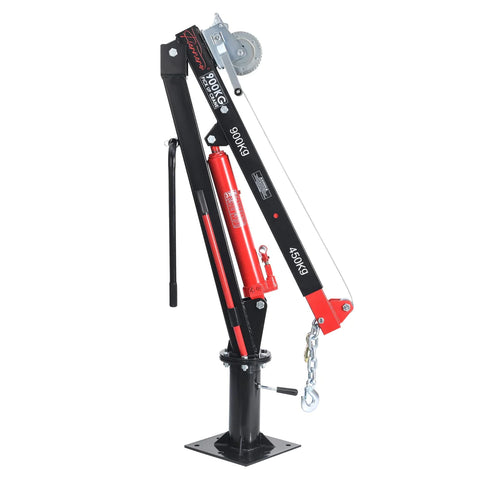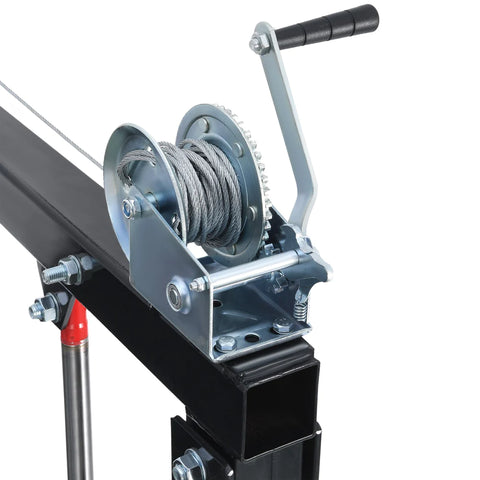Choosing the right engine crane is a pivotal decision for professionals and enthusiasts alike in the automotive repair and maintenance world. Whether lifting an engine for a routine overhaul or undertaking a full restoration project, the efficiency and safety of your work heavily depend on the type of engine crane you use. With hydraulic and electric engine cranes being the most prevalent options in the market, understanding the nuances between these two can significantly impact your project's success.
Let's dive into the world of engine cranes and discover which one you need for your automotive tasks.
Understanding Engine Cranes
Engine cranes are specialized equipment designed to lift, hold, and maneuver heavy engines out of vehicles during maintenance or repair tasks. These tools are indispensable in automotive workshops and garages, providing a safe and efficient method to handle engines without causing strain or injury. Engine cranes come in various forms, each suited to different working environments and project requirements. The primary types encountered in the automotive industry are hydraulic and electric engine cranes.
1. Hydraulic Engine Cranes

Hydraulic engine cranes operate on the principle of fluid mechanics, utilizing a hand pump to pressurize hydraulic fluid within a cylinder. This action extends the piston, creating a lifting force that raises the engine. The simplicity of their design and the mechanical advantage provided by hydraulics make these cranes powerful and reliable. Typically mounted on wheels, they offer flexibility in movement and are favored for their durability and ease of repair.
2. Electric Engine Cranes

Electric engine cranes, on the other hand, rely on electrical power to operate a motor that lifts the engine. These cranes offer the convenience of effortless lifting at the push of a button, reducing manual labor and increasing precision in control. Electric cranes are particularly beneficial in high-volume settings where efficiency and speed are paramount. However, they require access to a power source, which may limit their mobility compared to their hydraulic counterparts.
Both types of engine cranes have their unique set of advantages and are designed to meet the demands of different automotive tasks. The choice between hydraulic and electric engine cranes depends on several factors, including the specific requirements of the work at hand, the frequency of use, and the physical conditions of the workspace. In the following sections, we'll dive deeper into the pros and cons of each type to help you determine which engine crane best suits your automotive projects.
Hydraulic Engine Cranes
Hydraulic engine cranes are powered by a manual pump or foot pedal that pressurizes hydraulic fluid in a cylinder, extending a piston to lift the engine. Their robust design and straightforward operation make them a staple in both professional and home garages.
Advantages

- Powerful Lifting Capacity: Thanks to the hydraulic mechanism, these cranes can lift heavy engines with relative ease, making them suitable for a wide range of automotive tasks.
- Durability: Hydraulic cranes are known for their rugged construction. They can withstand harsh working conditions and heavy use, ensuring longevity.
- Cost-Effectiveness: Generally, hydraulic engine cranes are more affordable than their electric counterparts. They offer great value, especially for those who need a reliable lifting solution without the additional cost of electric components.
Disadvantages
- Manual Operation: The need for physical effort to operate the pump can be a downside, especially in tasks requiring multiple lifts over a short period.
- Maintenance: While durable, hydraulic systems require regular maintenance, including fluid checks and potential leak repairs, to keep them operating smoothly.
- Mobility and Space: Some models can be bulky and require significant storage space. Additionally, the manual operation might limit their mobility in tighter spaces.
Electric Engine Cranes

Electric engine cranes utilize an electric motor to lift and lower loads, offering a convenient and user-friendly solution for handling engines. They are especially useful in environments where speed and efficiency are priorities.
Advantages
- Ease of Use: With simple button controls, electric cranes make lifting operations effortless, reducing physical strain and improving workflow.
- Consistent Performance: Electric motors provide a steady lifting speed and force, ensuring smooth operation and greater control over the lifting process.
- Reduced Physical Effort: The automated lifting mechanism eliminates the need for manual pumping, making it easier to use, especially for repeated lifting tasks.
Disadvantages
- Higher Cost: Electric cranes tend to be more expensive due to their advanced technology and components, which might not be justifiable for occasional use.
- Power Source Dependency: Being reliant on electricity limits the mobility of these cranes and may not be suitable for all workshop layouts or remote locations.
- Maintenance and Repairs: Electric components and motors can require specialized maintenance and are generally more costly to repair than hydraulic systems.
Comparative Analysis
When deciding between a hydraulic and electric engine crane, consider the lifting capacity required for your projects, ease of use preferences, maintenance capabilities, and cost implications. Hydraulic cranes offer robustness and value, suitable for varied lifting needs and environments where manual operation is not a concern. Electric cranes shine in high-volume settings or when ease and speed of operation are paramount, albeit at a higher cost and with some limitations on mobility.
Use Cases and Recommendations
The decision between hydraulic and electric engine cranes hinges on your specific project requirements, workspace dynamics, and personal preferences. Each type has its ideal scenarios where its advantages can be fully leveraged.
- Hydraulic Engine Cranes: Best suited for environments where durability and versatility are key. If you're working in a setting that demands the lifting of various engine types and weights, and where manual operation is not a deterrent, the hydraulic crane shines. It's particularly recommended for those who need a reliable tool for occasional to regular use, without the necessity for continuous power supply, and are looking for a cost-effective solution.
- Electric Engine Cranes: The go-to choice for high-paced professional workshops where efficiency and minimal physical effort are paramount. If your operations involve frequent engine lifts and you value the convenience of push-button operation, an electric crane can significantly enhance productivity. They're ideal in settings where the workflow is constant, access to power is not an issue, and the budget can accommodate a higher upfront investment.
Factors to Consider:
- Frequency of Use: Evaluate how often you'll be lifting engines. For sporadic use, a hydraulic crane might suffice, whereas frequent lifts could justify the investment in an electric model.
- Project Diversity: Consider the range of engines you work with. Hydraulic cranes offer robust flexibility for different weights, making them versatile for varied projects.
- Budget Constraints: Factor in your budget not only for the initial purchase but also for ongoing maintenance and potential repairs.
- Workspace Layout: Assess your workspace for power access and mobility. Electric cranes require a power source and might be less mobile, whereas hydraulic cranes offer greater placement flexibility.
By aligning your choice with these considerations, you can ensure that your engine crane not only fits your immediate needs but also serves as a long-term asset in your automotive projects, blending seamlessly into your workflow and enhancing your operational efficiency.
Making the Informed Choice
In navigating the choice between hydraulic and electric engine cranes, the key lies in matching the tool to your unique needs and operational context. Each type of crane carries its own set of strengths, designed to cater to different scenarios in the automotive maintenance and repair landscape. Whether your priority is the rugged versatility of hydraulic models or the streamlined efficiency of electric ones, understanding your workflow, project demands, and workspace requirements is crucial.
Browse our curated selection of engine cranes, where quality meets functionality. From robust hydraulic options to sophisticated electric models, discover the perfect addition to your workshop that aligns with our expert recommendations.
Explore our detailed guide for an in-depth look at engine cranes, and browse our selection to find the model that best suits your needs. Equip yourself with the right tools and knowledge to elevate your automotive projects to new heights of efficiency and safety.

